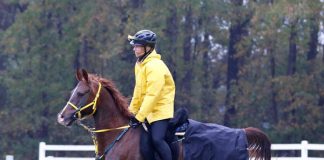 Back in 1972, a small group of Northern California distance horseback riders gathered to create an organization to recognize their riding accomplishments, standardize ride rules, and work to preserve trails. Still going strong, this month the American Endurance Ride Conference celebrates its 40th anniversary.
Back in 1972, a small group of Northern California distance horseback riders gathered to create an organization to recognize their riding accomplishments, standardize ride rules, and work to preserve trails. Still going strong, this month the American Endurance Ride Conference celebrates its 40th anniversary.
Perhaps the best known of all endurance rides is the venerable Western States Endurance Ride, commonly known as the Tevis Cup, which traverses the Sierra Nevadas from near Lake Tahoe to Auburn under the full moon one summer night each year. Today, hundreds of rides are sanctioned by AERC across the U.S. and Canada, ranging from 25 to 100 miles per day. Also popular are Pioneer Rides, which are a minimum of three consecutive days and 155 total miles.
Endurance riding grew from its humble California beginnings to become an internationally recognized sport. Hundreds of endurance rides are held annually around the U.S. and Canada, with everything from small, low-key rides to ultra-competitive races. The nation’s top riders are gearing up for the World Endurance Championships to be held Aug. 25 in England and the AERC National Championship rides Sept. 20 and 22 at the Biltmore Estate in Asheville, North Carolina.
The welfare of the horse is paramount in endurance riding, and veterinarians acting as control judges check the horses before, during and after the competition. Most new endurance riders begin with the 25-30 mile rides in the limited distance division. While there is no minimum time for completion of a ride, the maximum time for a 25-mile ride is six hours. When riders are ready to move up to 50-mile rides, the time limit jumps to 12 hours, including mandatory rest stops. For the 100-mile rides, horse-and-rider teams have 24 hours to complete the ride.
All equines are eligible to compete, and while Arabian horses proliferate, there are a growing number of gaited horses participating. Mules and Quarter Horses are common mounts, but even draft horses and at least one zebra have competed in endurance.
Endurance riding is truly a sport for every horseman with a fit horse. And one of those original six rules which is still in force is that “everyone finishing a ride shall receive a completion award.” As AERC motto states, “to finish is to win.”
All ages are welcome at endurance competitions. “Endurance riding is truly a family sport, allowing lots of family bonding time while traversing some beautiful countryside,” said AERC Executive Director Kathleen Henkel. “Moms, dads, and even grandparents can participate on the trails with junior riders.”
Rho Bailey, one of AERC’s founders who works part-time at the office, said, “Nothing matches the satisfaction and feeling of accomplishment of finishing a 50- or 100-mile [ride.]
“Being able to see territory and trails you would never see otherwise is one of the special things about endurance riding,” she added. The other is the bond that develops between horse and rider. “You really depend on each other out on the trail.”
No matter how much the sport has changed, she said that three things will always remain the same: “It will always be fun, competitive and educational.”
The organization’s national office tracks miles and points for all members and their horses, and confers annual awards in both regional and national competitions, including a family award and an award given to the rider 65 or older who completes the most miles each year.
AERC’s monthly publication, Endurance News, includes an extensive ride calendar and awards standings each month as well as education articles and features. Memberships are $75 per year, with a 15% discount for first-time members.
More information on endurance riding is available by visiting www.aerc.org






What a wonderful history this ride must have.
Congratulations!
Congrats
Congrats